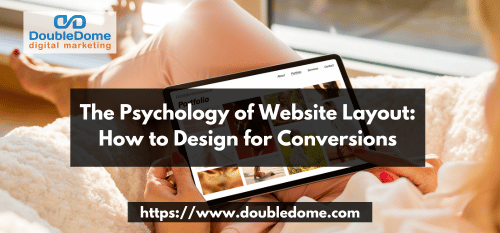By Jo Medico
Today, we’re going to dive into something super cool: the psychology of website layout. Now, you might be wondering what that means, but don’t worry, we’ll break it down in simple terms. Imagine you’re setting up a lemonade stand, and you want people to buy your lemonade. How you arrange your stand and the tasty lemonade can make a big difference. The same goes for websites! So, let’s learn how to design websites that make people want to click, buy, and stay a while.

The First Impression
When someone visits your website, it’s like meeting a new friend. First impressions matter! Here’s how you can create a fantastic first impression on your website:
Choose the Right Colors
Think about colors like red, blue, or green. Each color can make people feel different things. For example, red might make them excited, while blue might make them calm. Choose colors that match the feeling you want your website to have.
Example: Facebook uses blue for a calm and friendly vibe.
Clear Logo and Name
Imagine your lemonade stand without a sign. People wouldn’t know what you’re selling! On your website, make sure your logo and website name are easy to see. This helps visitors know they’re in the right place.
Example: The Nike website has a clear logo and name.
Big and Beautiful Pictures
Just like a yummy picture of your lemonade makes people thirsty, nice pictures on your website grab attention. Use big, high-quality images that show what your website is about.
Example: Airbnb uses stunning pictures of places to stay.
Easy Navigation
Now that you’ve made a good first impression, let’s talk about helping your visitors find their way around your website.
Simple Menu
Imagine if your lemonade stand had ten different menus, and your customers had to search for the lemonade! Make your website menu simple with clear labels, like “Home,” “About Us,” and “Contact.”
Example: Amazon’s menu is easy to follow with categories like “Books” and “Electronics.”
Search Bar
Sometimes, your visitors know exactly what they want. A search bar is like a magic tool to help them find it quickly.
Example: Google’s search bar is super simple yet powerful.
Links That Look Clickable
Links are like stepping stones on your website’s path. Make them stand out by changing their color or underlining them. People will know where to click!
Example: Wikipedia uses blue links that are easy to spot.
The Power of Storytelling
Now, let’s talk about something exciting – storytelling on your website!
Hero Image and Tagline
Just like a storybook cover, your website should have a hero image (a big picture) and a tagline (a short sentence) that tell visitors what your website is all about.
Example: Disney’s website has a magical hero image with the tagline, “The Official Home for All Things Disney.”
Customer Reviews and Testimonials
Imagine if your friend said your lemonade was the best! Share what your customers say about your product or service. It helps build trust.
Example: Amazon shows customer reviews to help you decide what to buy.
About Us Page
Every story has characters. On your “About Us” page, introduce yourself or your team. People like to know who they’re dealing with.
Example: Apple’s “About Us” page talks about their team and mission.
The Secret of Buttons
Buttons are like the “Buy Now” sign on your lemonade stand. Let’s see how they work on websites!
Make Buttons Stand Out
Buttons should be colorful and easy to see. Use contrasting colors to make them pop.
Example: On Netflix, the “Watch Now” button is red, which stands out against the black background.
Use Action Words
Buttons should say what they do. Instead of “Click Here,” use words like “Buy,” “Sign Up,” or “Get Started.”
Example: Dropbox uses “Sign Up for Free” instead of just “Sign Up.”
Keep It Simple
Don’t clutter your buttons with too much text. Make them clear and easy to understand.
Example: YouTube’s “Subscribe” button is simple and clear.
Mobile-Friendly Magic
More and more people use phones and tablets to browse the web. Let’s make sure your website works like magic on these devices!
Responsive Design
Your website should look good and work well on small screens. It should adjust to fit different devices, like phones and tablets.
Example: The BBC website looks great on both computers and phones.
Big Buttons and Text
On tiny screens, it’s hard to tap small buttons or read tiny text. Make everything bigger and touch-friendly for mobile users.
Example: The Airbnb app has big buttons for easy booking.
Trust Signals
Imagine if your lemonade stand had a certificate that said your lemonade was super safe to drink. People would trust you more. Your website needs trust signals too!
Security Badges
Show badges that tell people their information is safe with you. This can be a padlock or a “Secure” label.
Example: PayPal uses a padlock to show that transactions are secure.
Trustworthy Contact Info
Share your contact information so people know you’re real. An email address and phone number can do wonders!
Example: Microsoft’s website has clear contact info in the footer.
Privacy Policy
Imagine if you told your customers that you wouldn’t share their lemonade secrets. A privacy policy is like that. It tells people how you’ll use their information.
Example: Facebook’s privacy policy explains how they protect user data.
Testing and Tweaking
You’ve designed an amazing website, but it’s not over yet! You should keep improving it.
A/B Testing
Try different versions of your website to see which one works better. It’s like testing two lemonade recipes to find the tastiest one.
Example: Google ran A/B tests to find the best shade of blue for links.
User Feedback
Ask your visitors for feedback. They can tell you what they like or don’t like about your website.
Example: Amazon asks for reviews and ratings after purchases.
Conclusion
Wow, we’ve covered a lot! Remember, designing a website that makes people stay, click, and buy is like setting up a fantastic lemonade stand. You want to create a welcoming first impression, make navigation easy, tell a great story, have inviting buttons, be mobile-friendly, show trust signals, and keep improving.
Just like making lemonade, website design takes practice. So, keep learning, experimenting, and having fun with it! You’ve got this!








